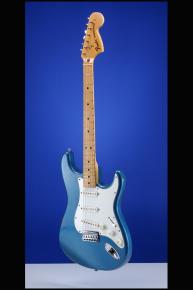A Super Light Lake Placid Blue "Hardtail" Stratocaster
This super light Lake Placid Blue "Hardtail" Stratocaster weighs just 7.20 lbs. and has a nut width of just under 1 5/8 inches and a scale length of 25 1/2 inches. Solid alder body, contoured on back and lower bass bout, one-piece maple fretted neck with 21 frets and black dot position markers. Two "butterfly" string trees, one with nylon spacer. Large headstock with decal logo with "Fender" in black with gold trim, "STRATOCASTER" in black beside it, and one patent number ("3,143,028") beneath "Fender." Individual Fender "F" closed-back tuners with octagonal metal buttons. Three-bolt neck plate with large Fender "F" logo and with serial number ("398898") between the top two screws. Three single-coil gray bottom pickups with staggered polepieces and balanced outputs of 5.43k, 5.49k, and 5.51k, each one stamped "17 12 73" on the underside. Three-layer (white/black/white) plastic pickguard with eleven screws. Three controls (one volume, two tone) plus three-way selector switch, all on pickguard. White plastic Stratocaster knobs with greenish gold lettering. Fender combined six-saddle bridge/tailpiece stamped with the part number ("010347") at the string ball end. The neck is stamped "22 FEB 73B," the potentiometers are stamped "137 7304" (Stackpole January 1973), and the neck cavity is stamped "T. Chalmers" and "Gabe." The bridge pickup cavity has been very slightly deepened (we can't say why this was done because there is no evidence that the electronics have been changed -- and all three pickups are certainly original to this guitar). This guitar is in excellent plus (8.75) condition. There is a minimal amount of belt buckle wear on the back of the guitar (not through to the wood), some arm playing wear on the upper bass bout (just through to the wood), a couple of dings on the treble edge of the guitar, and a couple of chips on the edge of the treble horn. There is a just little bit of fretwear. The guitar plays great and sounds great. And it is totally unfaded -- no fading and no greening. Housed in its original Fender black hardshell case with dark orange plush lining (9.00).
"The Stratocaster was launched during 1954 [and was priced at $249.50, or $229.50 without vibrato]...The new Fender guitar was the first solidbody electric with three pickups [Gibson's electric-acoustic ES-5, introduced five years earlier, had been the overall first], meaning a range of fresh tones, and featured a new-design vibrato unit that provided pitch-bending and shimmering chordal effects. The new vibrato -- erroneously called a 'tremolo' by Fender and many others since -- was troublesome in development. But the result was the first self-contained vibrato unit: an adjustable bridge, a tailpiece, and a vibrato system, all in one. It wasn't a simple mechanism for the time, but a reasonably effective one...Fender's new vibrato had six bridge-pieces, one for each string, adjustable for height and length, which meant that the feel of the strings could be personalized and the guitar made more in tune with itself...The Strat came with a radically sleek, solid body, based on the outline of the 1951 Fender Precision Bass. Some musicians had complained to Fender that the sharp edge of the Telecaster's body was uncomfortable...so the Strat's body was contoured for the player's comfort. Also, it was finished in a yellow-to-black sunburst finish. Even the jack socket mounting was new, recessed in a stylish plate on the body face...the Fender Stratocaster looked like no other guitar around especially the flowing, sensual curves of that beautifully proportioned, timeless body. The Stratocaster's new-style pickguard complemented the lines perfectly, and the overall impression was of a guitar where all the components ideally suited one another. The Fender Stratocaster has since become the most popular, the most copied, the most desired, and very probably the most played solid electric guitar ever" (Tony Bacon, 50 Years of Fender, p. 18).
Translate:








